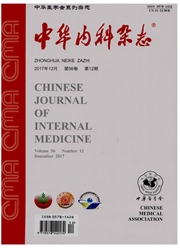

 中文摘要:
中文摘要:
探讨氧化应激DNA损伤水平在活动性Graves眼病(Graves’ophthalmopathy,G0)患者经糖皮质激素治疗后的变化情况。与对照组和Graves病(GD)组相比,GO组的血清8-羟基脱氧鸟嘌呤(8-hydroxy-deoxyguanosine,8-OHdG)显著增高(P〈0.05);GO患者经糖皮质激素治疗后血清8-OHdG水平及临床疾病活动分数(clinicalactivityscoYe)较治疗前显著降低(P〈0.05);治疗后的血清8-OHdG水平低于GD组(P〈0.05)。氧化应激参与GO的发病,GO患者的血清8-OHdG水平经糖皮质激素治疗后明显下降,可作为判断GO治疗效果的良好指标。
 英文摘要:
英文摘要:
The change in serum level of 8-hydroxy-deoxyguanosine (8-OHdG), an oxidative stress biomarker, in patients with active Graves' ophthalmopathy (GO) during corticosteroid treatment was observed. The serum level of 8-OHdG was significantly increased in patients with active GO as compared with that of normal controls and patients with Graves' disease (P 〈 0.05 ). After systemic corticosteroid treatment, patients with GO showed significantly lowered 8-OHdG level as compared with that before treatment and patients with Graves' disease. These changes in serum 8-OHdG level were accompanied by decreases in clinical activity score (P 〈 0. 05 ) during corticosteroid treatment. Oxidative stress may play a role in the pathogenesis of GO. Serum 8-OHdG level may be used as an objective and quantitative parameter in patients with GO during immunosuppressive treatment.
 同期刊论文项目
同期刊论文项目
 同项目期刊论文
同项目期刊论文
 期刊信息
期刊信息
